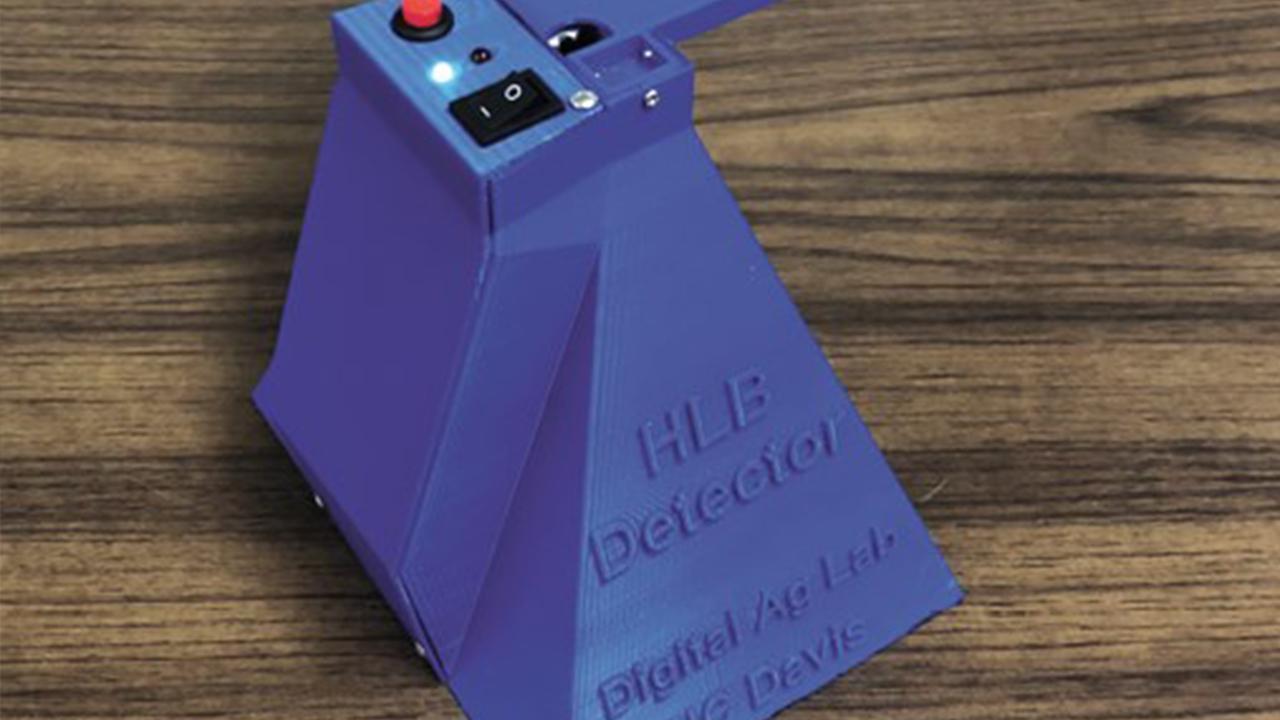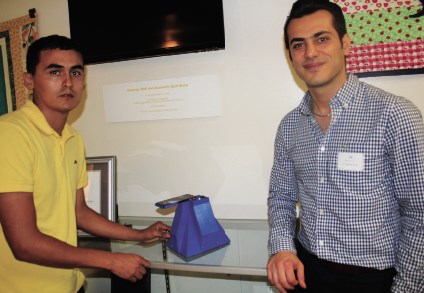
Sensing device can detect huanglongbing early
(Originally published in Ag Alert and courtesy of the California Farm Bureau Federation)
A researcher from the University of California, Davis, is seeking to commercialize equipment that could be used as an early warning device to detect a deadly disease in citrus long before trees show signs of infection.
Alireza Pourreza, a Cooperative Extension specialist with the Department of Biological and Agricultural Engineering, was among inventors of an optical sensing device that detects a buildup of starch in leaves that can be an early indication of infection from huanglongbing. Pourreza leads the Digital Agricultural Lab at UC Davis.
The disease has crippled the Florida citrus business, and there is concern it could do the same thing in California and elsewhere. A key to stopping that from happening is early detection, Pourreza said. If infection can be detected early, a diseased tree can be removed before the Asian citrus psyllid feeds on it and spreads bacteria throughout an orchard.
"There is no treatment for the disease," Pourreza said. "It's best to identify infected trees and remove them as soon as possible."
He explained the device can be used to distinguish between infected and non-infected leaves and to draw a distinction concerning leaf discoloration that may resemble HLB-infection, including that caused by magnesium, nitrogen and zinc deficiency.
A PCR (polymer chain reaction) test could be used to confirm infection, but Pourreza said he believes the device greatly increases the odds of finding infected plant material.
The device helps in indirectly detecting Candidatus Liberbacter asiaticus, the bacterium that causes HLB.
Pourreza talked at the Kearney Agricultural Research and Extension Center in Parlier of using a cellphone on the very portable device after downloading an app. His address came during an open farm event that showcased use of new technologies in agriculture.
Pourreza said the idea in developing the device was to "make it so inexpensive anyone could use it."

He does not know what its price would be, but said he hopes a company will step forward to license and develop it. He said he envisions its commercialization would result in better detection if the devices could be put in more hands at a lower cost.
He said he sees a market among government regulators such as the U.S. Department of Agriculture and California Department of Food and Agriculture, as well as growers, extension specialists and pest control advisors. It could also be used for border security.
To increase its effectiveness, Pourreza said, a large library of photos would need to be amassed. That's because the device would benefit from "machine learning, deep learning." In other words, it would teach itself, Pourreza said, much as Facebook is able use methodology whereby It can confirm who the user is by showing pictures that he or she recognizes,
"It would take six to nine months to calibrate before it would be available," Pourreza said. "The technology has been proven to work."
Pourreza shares a patent with Won-Suk Lee, with the University of Florida, Gainesville; Reza Ehsani, with UC Merced; and Evan Raveh, with the Volcani Agricultural Institute in Israel.
Pourreza said a first prototype of the device showed overall accuracy of 93 percent in detecting leaves with HLB.
The open farm event began with Jeff Dahlberg, director of the Kearney center, talking of its becoming "fully wi-fi" two months earlier, which he sees as a major boon to researchers. A sorghum breeder, Dahlberg said having wi-fi access, "anywhere we go" helps in real-time monitoring.
He said it also provides applications in rural communities. UC has been working with a company that works in Africa to provide wi-fi, where most installations are solar powered.
"Israel has been doing this for some time," Dahlberg said. He said having real-time measurements can, for example, be key to soil moisture monitoring and applying irrigation water when it is needed.
In an afternoon talk, Glenda Humiston, vice president for UC Ag and Natural Resources, spoke about how broadband infrastructure is enabling new applications and more collaboration.
She said some communities, however, are struggling with bandwidth speed and quality, and she would like to see that addressed in rural areas.
"State and federal funding are available for broadband," she said, "but existing carriers often claim they are already servicing an area, and there are not good enough maps to show that."
Humiston said she plans to enlist the help of 4-H members to test quality and speed of connections and will be working with the California Public Utilities Commission to improve maps.
"Next April, we will run apps several times a day for a week," Humiston said. "We want 4-Hers to go tell their story.
She closed by lamenting the state's cuts in Cooperative Extension positions.
"We have half the UCCE people in the field that we had 20 years ago," Humiston said. "We have got to quit hemorrhaging our Cooperative Extension system."
Media contact
Dennis Pollock, agcompollock@yahoo.com